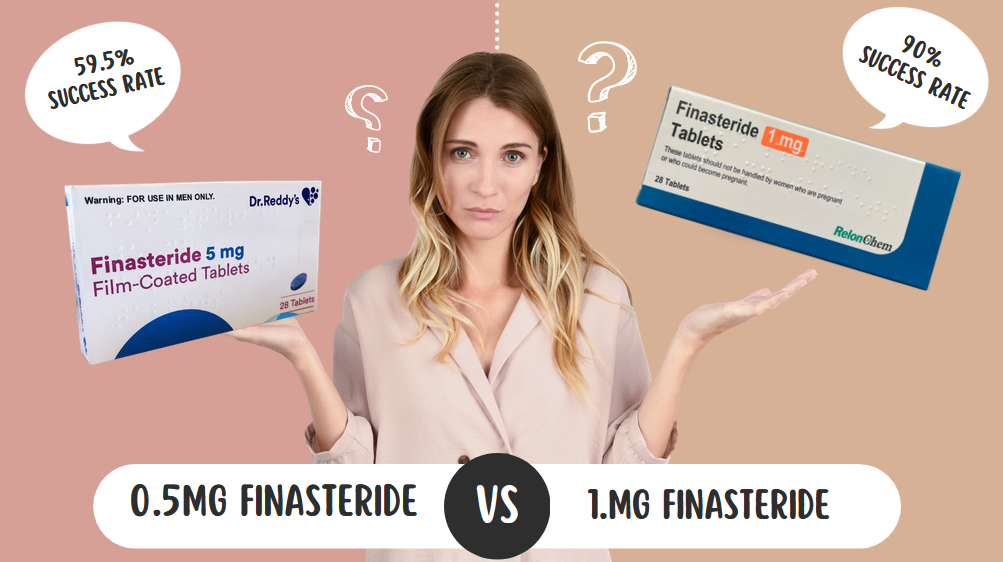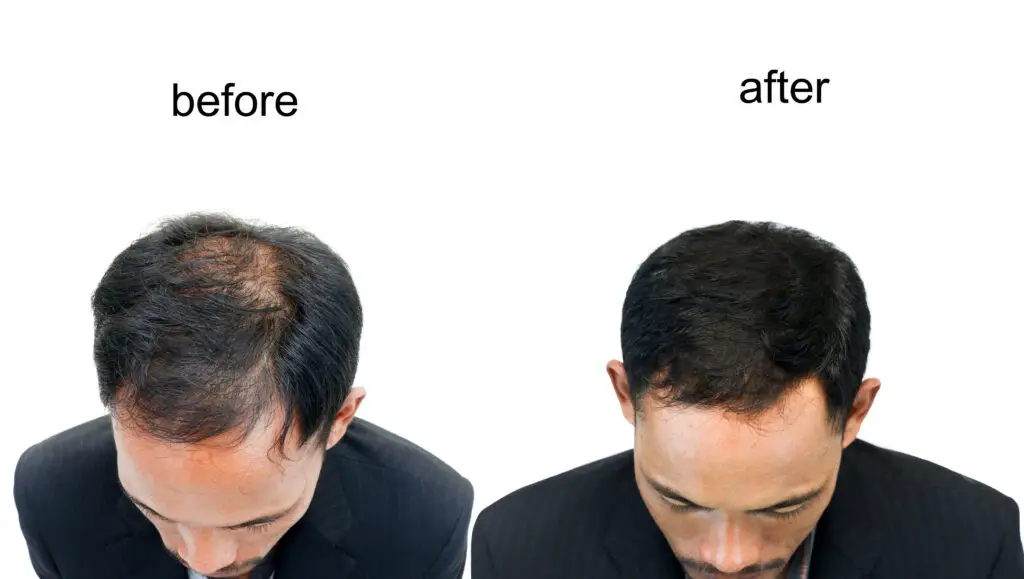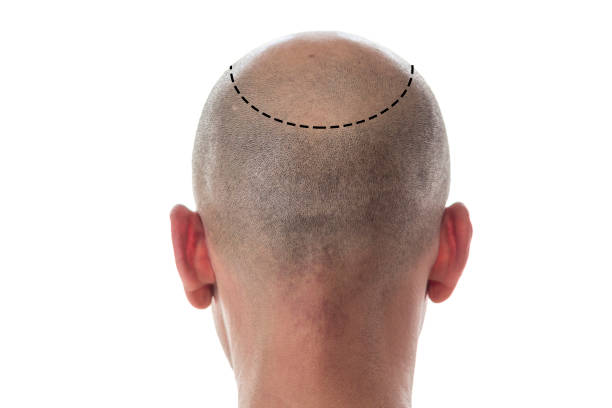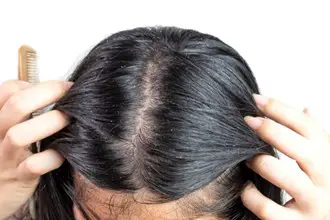Explore the differences between 0.5mg finasteride vs 1mg for hair loss treatment, understanding their efficacy, side effects, and optimal dosing
In the world of hair loss treatments, finasteride stands out as a beacon of hope for many. It’s a journey I’ve navigated personally and professionally, understanding the nuances of how to use finasteride. Today, we’re delving into a crucial aspect of this journey: the debate between 0.5mg and 1mg dosages of finasteride.
Finasteride, primarily known for its role in treating male pattern baldness, works by inhibiting the conversion of testosterone to dihydrotestosterone (DHT), a key player in hair follicle miniaturization. The effectiveness of finasteride in promoting hair regrowth and slowing hair loss is well-documented, but the question of the optimal dosage remains a topic of discussion among experts and users alike.
Choosing the right finasteride dosages for hair loss is a balancing act. The finasteride 1mg dose, often hailed as the standard, causes significant hair regrowth. However, the appearance of 0.5mg finasteride every other day has opened discussions about reducing potential side effects from finasteride while maintaining effectiveness.
Deciding on your finasteride dosages for hair loss is a significant choice, and I always endorse consulting with healthcare professionals to tailor the treatment to your specific needs. For those wishing to take finasteride, understanding the differences between dosages is key when deciding whether or not finasteride is worth the risk of sexual side effects.
Discover more about finasteride’s role in hair loss treatment and how to navigate these options for your hair health journey.
Table of Contents
ToggleUnderstanding Finasteride: How It Works for Hair Loss
Embarking on a hair loss treatment journey with finasteride is a decision many faces. As someone who’s navigated these waters, I can share first-hand how finasteride tackles the root cause of male pattern baldness. It’s not just a treatment; it’s a science-backed approach to hair restoration.
At its core, finasteride operates by targeting a key hormone: dihydrotestosterone (DHT). DHT, derived from testosterone, plays a notorious role in hair follicle miniaturization, a primary factor in male pattern hair loss. Finasteride steps in as a DHT blocker, reducing its production and thereby slowing down hair loss. This mechanism is crucial because it addresses the problem at its hormonal source, offering a ray of hope for those struggling with thinning hair.
Understanding the role of DHT is pivotal in appreciating how finasteride works. By reducing DHT levels, finasteride not only halts the progression of hair loss but also fosters an environment conducive to hair regrowth. This dual action makes it a cornerstone in hair loss treatment. For a deeper dive into the science behind finasteride, explore this comprehensive study.

No matter how much hair is gone — it CAN come back.
Stimulate growth safely and comfortably with FDA-PROVEN (LLLT) LASER THERAPY CAP. Hair Transplant Surgeon, Dr. Vikram Jayaprakash and Dermatologist, Dr. Russell Knudsen speak about how hair loss happens and why a laser cap is their preferred laser hair therapy device to help restore hair growth.
WATCH NOWDifferences Between 0.5mg Finasteride vs 1mg Dosages
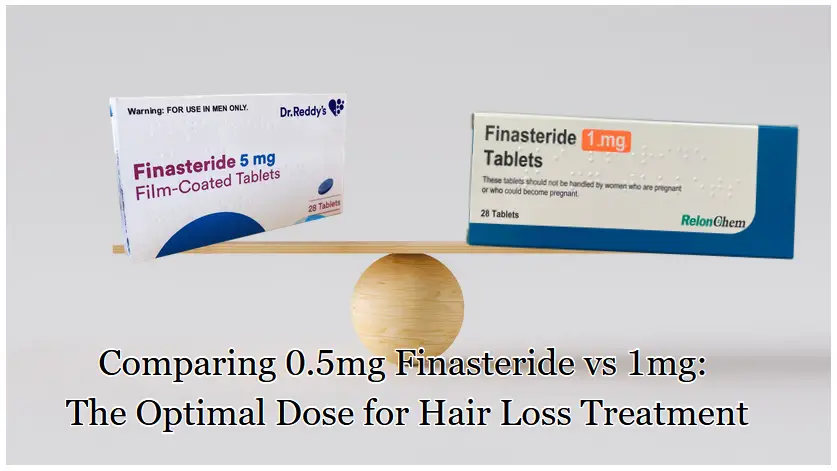
In the context of hair loss treatment, understanding the differences between 0.5mg and 1mg dosages of finasteride is crucial. This comparison not only relates to how finasteride works in combating hair loss but also to the efficacy of these specific dosages.
The Standard Dose: Benefits of 1mg Finasteride
In the realm of hair loss treatments, the 1mg dose of finasteride has emerged as a standard bearer. Through my journey and research, I’ve seen how this particular dosage has become a go-to solution for many battling male pattern baldness. Let’s delve into the benefits and effectiveness of this dosage, backed by clinical studies.
1mg finasteride offers a beacon of hope for hair regrowth, with studies showing its significant impact:
- Increased Hair Growth: Clinical trials, like a Phase III study, have demonstrated that 1mg finasteride daily can significantly increase hair growth over a period of two years.
- Slowing Hair Loss Progression: Not only does it aid in regrowth, but it also effectively slows down the progression of hair loss.
- High Success Rate: With up to a 90% success rate in combating hair loss, it stands as a highly effective treatment option.
- Minimal Side Effects: The low incidence of adverse effects, as noted in the Propecia product label, underscores its safety profile.
Finasteride’s mechanism is straightforward yet powerful. It reduces the body’s DHT levels, a key culprit in hair follicle miniaturization. While it’s a game-changer for adult men, it’s crucial to remember that it’s not suitable for women or children. Also, while not a preventive measure for prostate cancer, its role in treating symptoms of benign prostatic hyperplasia (BPH) is noteworthy. However, it’s essential to weigh the benefits against the risks, especially concerning the slight increase in the risk of a serious form of prostate cancer.
For those considering this treatment, I always recommend a thorough discussion with your doctor. Understanding the full scope of finasteride’s impact is key to making an informed decision for your hair health journey. Explore more about finasteride and its role in hair loss treatment at Mayo Clinic.
Lower Dosing: Examining 0.5mg Finasteride Efficacy
In the landscape of hair loss treatments, the efficacy of lower doses of finasteride, particularly 0.5mg, has sparked interest and debate. Drawing from my experience and extensive research, let’s explore how this reduced dosage measures up in treating male pattern hair loss.
Recent studies shed light on the effectiveness of 0.5mg finasteride:
- Moderate Success Rate: A Japanese pilot study reported that 0.5mg finasteride was effective in 59.5% of patients, particularly those with hair growth in other body areas.
- Promotes Scalp Hair Growth: Research, including a comprehensive review, has found that even at this lower dose, finasteride can promote scalp hair growth and prevent further hair loss in a significant number of men.
- Long-Term Efficacy: Long-term studies, as seen in Japanese and Korean research, demonstrate the sustainable effects of 0.5mg finasteride over 5-10 years.
However, it’s crucial to contextualize these findings. While 0.5mg finasteride shows promise, studies indicate that the optimal dose for treating male pattern hair loss is 1mg. This is supported by research suggesting that while the 5mg dose, typically used for benign prostatic hyperplasia, does benefit hair loss, the clinical advantages seem to plateau at 1mg. The Mayo Clinic recommends a 5mg dosage for BPH, highlighting that 0.5mg is below the effective range for hair loss treatment.
While 0.5mg finasteride presents a lower risk of side effects, its efficacy in hair loss treatment is less established compared to the 1mg dosage. It’s essential to consult with healthcare professionals to determine the most suitable treatment plan for your specific needs.
Side Effects: 1mg vs 0.5mg Finasteride
When considering finasteride for hair loss treatment, understanding the side effects of different dosages is crucial. From my research and experience, it’s clear that both 1mg and 0.5mg dosages of finasteride have their own set of side effects, with variations in severity and frequency.
Here’s a detailed comparison based on recent studies:
| Side Effect | 1mg Finasteride | 0.5mg Finasteride |
|---|---|---|
| Decreased Libido | Common | Less Common |
| Erectile Dysfunction | More Frequent | Less Frequent |
| Ejaculation Disorder | Occasional | Rare |
| Rash | Rare | Very Rare |
| Breast Tissue Enlargement | Rare | Very Rare |
| Tenderness | Rare | Very Rare |
The most common side effects at the 1mg dose include decreased libido, erectile dysfunction, and ejaculation disorder. A study suggests that these sexual adverse effects occur at rates of 2.1% to 3.8%, with erectile dysfunction being the most prevalent.
In contrast, the 0.5mg dosage, while still presenting similar side effects, tends to have them at a reduced frequency and severity. This lower dosage may be associated with reduced chances of side effects, making it a consideration for those concerned about these issues.
It’s important to note that while the 5mg dose, often used for benign prostatic hyperplasia, has additional side effects like rash and breast tissue enlargement, these are less prominent in the lower dosages used for hair loss.
Deciding on the right dosage of finasteride is a personal journey, one that should be navigated with the guidance of a healthcare professional. For more insights into the experiences of finasteride users, check out Hims Bad Reviews.
Patient Experiences: Real Stories of Finasteride Users
In the journey of hair loss treatment, personal experiences with finasteride offer invaluable insights. As someone who values real-world stories, I’ve gathered testimonials from various sources to shed light on the experiences with different dosages of finasteride.
One Reddit user, u/Few_Potato6398, shared their uncertainty about the effects of finasteride 5mg after starting hormone replacement therapy. This highlights the complexity and individual nature of hair loss treatment, where factors like additional medications can influence results.
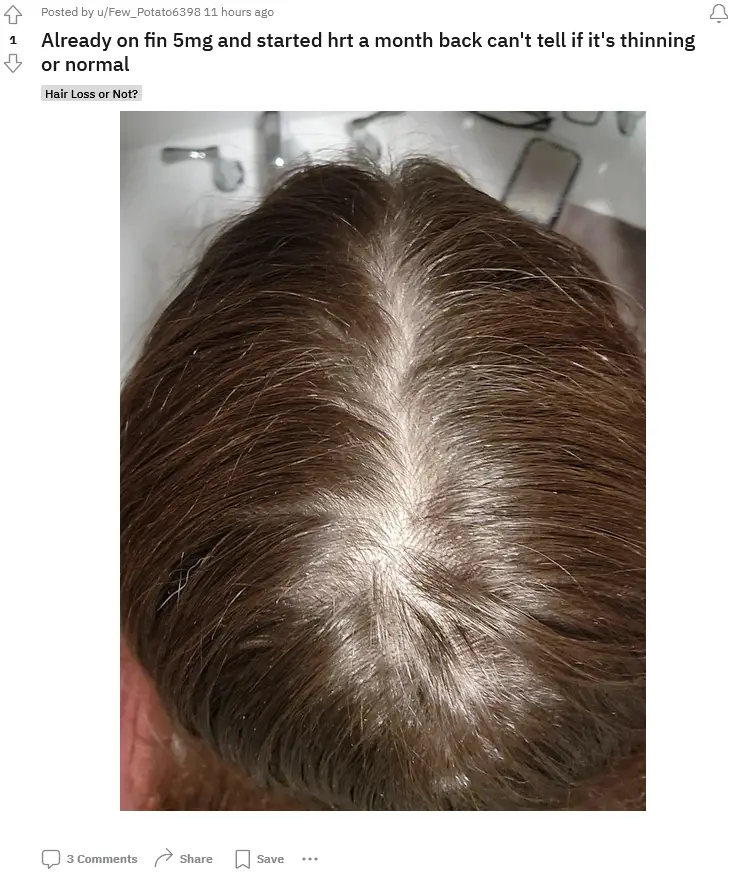
On the other hand, reviews from Keeps Finasteride users paint a more positive picture. Dean, a verified buyer, rated it 5 stars, sharing his success in regrowing hair, particularly in the front. Another user, Andrew, echoes this sentiment, noting significant hair regrowth since using Keeps, emphasizing its affordability and effectiveness.
These stories underscore the varied responses to finasteride. While some experience remarkable regrowth, others may face uncertainties or less pronounced results. It’s a reminder that hair loss treatment is a personal journey, often requiring tailored approaches.
For those considering finasteride, whether oral or topical, exploring more stories and information can be incredibly helpful.
learn more about purchasing options at Buy Finasteride Online.
Topical vs Oral Finasteride: Exploring Alternatives
In the quest to combat hair loss, the choice between topical and oral finasteride is a pivotal decision. As someone who values informed choices, let’s explore these alternatives, understanding their efficacy and suitability.
- Topical Finasteride: This form is applied directly to the scalp. It’s known for its effectiveness in treating hair loss, potentially offering fewer systemic side effects than its oral counterpart. This makes it a viable option for those seeking a more localized treatment.
- Dutasteride: Similar to finasteride, dutasteride also inhibits DHT and is available in both oral and topical forms. It might be a suitable alternative for individuals who don’t respond well to finasteride.
- DHT-Blocking Shampoos and Products: Various shampoos and products claim to block DHT. While their effectiveness may not be as robust as finasteride, they can be a supplementary approach in hair loss management.
- Natural DHT Blockers: Ingredients like saw palmetto, biotin, and zinc are touted as natural alternatives. While evidence of their effectiveness is limited, they are preferred by those inclined towards natural remedies.
- Low-Level Light Therapy (LLLT): This non-invasive treatment uses light to stimulate hair growth. Available in forms like laser combs and helmets, LLLT is an option for those averse to medication.
Each of these alternatives has its unique attributes and effectiveness, which can vary from person to person. It’s crucial to consult with a healthcare professional before embarking on any new treatment for hair loss. For a more in-depth comparison, explore Topical Finasteride vs Oral.
Expert Opinions: What Doctors Say About Finasteride Dosing

In the realm of hair loss treatment, understanding the optimal dosage of finasteride is crucial. Drawing from my experience and the insights of medical professionals, let’s delve into what doctors recommend for finasteride dosing at different stages of hair loss.
The standard dosage for hair loss is typically 1 mg per day. This dosage has been proven effective in significantly reducing dihydrotestosterone (DHT) levels, thereby slowing down or even halting hair loss. The treatment timeline, as outlined by experts, generally follows these stages:
- First 1-3 Months: Initial hair shedding may occur, a normal part of the hair regrowth process.
- 3-6 Months: New hair growth might start to become visible, with a decrease in shedding. However, significant results may not be apparent yet.
- 6-12 Months: Many users observe a noticeable reduction in hair loss and some hair regrowth. Studies have shown significant increases in hair count and thickness after 12 months of treatment.
- After 12 Months: Continued use can lead to further improvements in hair count, thickness, and overall hair density.
It’s important to remember that individual responses to finasteride can vary. The timeline for results is not the same for everyone. Patience and consistent use are key. For concerns about progress, consulting a healthcare professional is advisable.
For treating symptoms of an enlarged prostate (benign prostatic hyperplasia), a higher dosage of 5 mg per day is prescribed. Adhering to the prescribed dosage is vital, as incorrect dosing can increase the risk of adverse effects.
Finasteride typically starts showing effects after three to four months, with significant, measurable improvements in hair count and thickness usually observed after 12 months. Initial shedding is normal, and it’s crucial to continue treatment for at least a year to evaluate its effectiveness. It’s generally more effective when used in combination with minoxidil, a topical medication that stimulates hair regrowth. If no improvement is noticed after 12 months, it’s unlikely that the medication will be beneficial.
For more detailed guidelines on the use of finasteride in androgenetic alopecia, visit International Journal of Dermatology, NCBI, and ScienceDirect.
Personalizing Treatment: Tailoring Finasteride Dose to Individual Needs
In the journey of treating hair loss, personalizing the finasteride treatment to fit individual needs is key. As someone who believes in tailored solutions, I understand that a one-size-fits-all approach doesn’t work in hair loss treatment. Let’s explore how finasteride dosage can vary based on individual factors.
- Age and Hair Loss Severity: The dosage of finasteride may need adjustment depending on the age of the individual and the severity of their hair loss. Younger individuals with mild hair loss might benefit from a lower dose, while those experiencing more advanced hair loss could require the standard 1mg dosage.
- Health Conditions and Medications: Other health conditions and medications can influence the effectiveness and side effects of finasteride. It’s crucial to consider these factors when determining the right dosage.
- Response to Treatment: The body’s response to finasteride can also dictate dosage adjustments. Some might see significant improvements with a lower dose, while others may need a higher dose for desired results.
The importance of consulting healthcare providers cannot be overstated. A healthcare professional can assess individual factors like age, health conditions, and hair loss progression to recommend the most appropriate finasteride dosage. They can also monitor the treatment’s effectiveness and make necessary adjustments.
For those considering finasteride, remember that your journey is unique. Tailoring the treatment to your specific needs is essential for the best outcomes. Always seek professional advice and never hesitate to discuss your concerns and expectations with your healthcare provider.
FAQs: on Finasteride Dosage
Navigating the world of finasteride dosage can be filled with questions. As someone who values clear and accurate information, I’ve compiled answers to some frequently asked questions to help guide your journey.
Is Half a Milligram (0.5mg) of Finasteride Effective?
0.5mg finasteride can be effective, especially for those looking for a balance between efficacy and minimizing potential side effects. While the standard dose is 1mg, recent studies suggest that 0.5mg may still provide benefits in hair regrowth and slowing hair loss, albeit potentially to a lesser extent.
Is It Possible to Split Finasteride Tablets for a 0.5mg Dose?
Yes, finasteride tablets can be cut in half to achieve a 0.5mg dose. This is a common practice for those who wish to start with a lower dose or for cost-saving purposes. However, it’s important to consult with your healthcare provider before making any changes to the prescribed dosage.
What is the Likelihood of Side Effects with 0.25mg Finasteride Use?
Using 0.25mg of finasteride typically reduces the likelihood of experiencing side effects. Lower doses have been associated with fewer instances of side effects like sexual dysfunction, though individual responses can vary.
What Occurs When You Miss a Finasteride Dose?
If you forget to take a dose of finasteride, take it as soon as you remember. However, if it’s almost time for your next dose, skip the missed dose and continue with your regular schedule. Do not take a double dose to make up for the missed one.
Does Finasteride Work for the Already Bald?
Finasteride is most effective in slowing hair loss and promoting regrowth in areas where some hair still exists. Its effectiveness in regrowing hair on completely bald areas is limited. It’s best used as a preventive measure or to enhance regrowth in thinning areas.
Remember, these answers are general guidelines. For personalized advice, it’s always best to consult with a healthcare professional who can provide guidance based on your specific situation and medical history.
Conclusion: Making an Informed Decision on Finasteride Dosage
As we conclude our exploration of finasteride dosages, it’s essential to underscore the key takeaways for making an informed decision. Choosing between 0.5mg and 1mg dosages of finasteride is a decision that hinges on various factors:
- Severity of Hair Loss: Consider the extent of your hair loss. The 1mg dose is typically more effective for advanced hair loss, while 0.5mg might suffice for milder cases.
- Side Effect Tolerance: Assess your tolerance for potential side effects. If you’re concerned about side effects, starting with a lower dose like 0.5mg may be prudent.
- Personal Medical History: Your overall health and any other medications you’re taking can influence how you respond to finasteride.
- Treatment Goals: Reflect on what you aim to achieve with the treatment, whether it’s slowing hair loss, regrowing hair, or both.
Remember, this journey is highly personal and varies from individual to individual. Consulting with healthcare professionals is paramount in tailoring the treatment to your specific needs. They can provide personalized advice, taking into account your unique circumstances, and guide you towards the most suitable dosage. Your path to managing hair loss is a collaborative one, and professional guidance is key to navigating it effectively.
Medically Team reviewed by Dr. Ljuba Zsolnai and updated. With professional help, Anthony research and only provide content that delivers results. The name "Stages of Balding" accurately reflects the blog's purpose: to provide practical solutions and guidance without requiring extensive research on the reader's part.
- AI Powered Bald Filter Online 2024: See Yourself with No Hair! - January 19, 2024
- Harklinikken Bad Reviews 2024: Analyzing Negative Feedbacks - January 18, 2024
- How to Get the Alex Eubank Hair | Step-By-Step Tutorial 2024 - January 18, 2024

